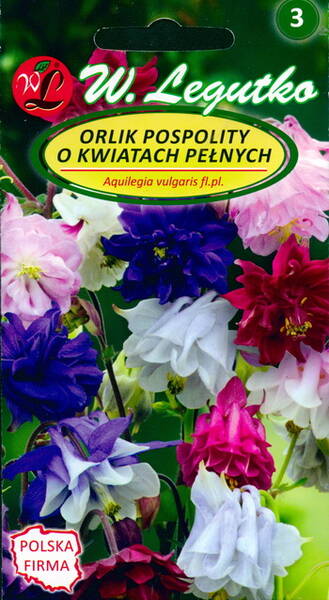A very decorative variety with unusual double flowers.
The plant grows 60-80 cm tall, with a spreading habit, 40-50 cm in diameter. The leaves are twice trifoliate and glaucous. The flowers are 4-5 cm in diameter and come in a variety of colors. It blooms in June-July. It is used for group plantings in flowerbeds, herbaceous borders, for cutting, and in dried winter arrangements.
Agricultural technology.
This undemanding plant achieves its greatest decorative effect when grown in semi-shaded areas and light, fairly moist soil. Seeds are sown directly into the ground in late April or May. At soil temperatures of 14°C to 18°C, seedlings emerge in 20-30 days. Plants should be spaced 30-40 cm apart.
* Work calendar:
March.
Seeds are sown in hotbeds or boxes in the room.
April - May.
Once the snow melts, remove dry leaves and stems, taking care not to damage young spring leaves. If young plants with roots were exposed to the soil surface in early spring due to frost heaving, carefully plant them deeper, taking care not to break the roots. Fertilize the plants with a complete mineral fertilizer or organic matter. Once the soil has warmed sufficiently, sow the seeds directly into the soil.
June - July.
After flowering and the flowering stems lose their decorative appeal, cut them back, leaving only the rosette of leaves. The cut parts can be composted, but if they are diseased, they should be burned. Some of the most attractive plants can be left uncut and used for seed production. To prevent unwanted seed shedding and self-seeding, the fruits should be isolated by placing them in gauze bags.
August.
The fruits with ripe seeds are harvested. They can be sown in boxes immediately after harvesting or later.
September - October.
Divide the bushes while replanting them. When replanting, identify any diseased plants and burn them. At the same time, plant the current year's seedlings, transplanted in the spring, in the fall. Mulch the base of the bushes with humus or compost.
* Work calendar:
March.
Seeds are sown in greenhouses or boxes in the room.
April - May.
As the snow melts, dry leaves and stems are removed, trying not to damage the young spring leaves. If in early spring young plants with roots end up on the soil surface as a result of frost bulging, they are carefully buried, trying not to break off the roots. Plantings are fed with complete mineral fertilizer or organic matter. After the ground has warmed up sufficiently, the seeds are sown in the ground.
June - July.
After flowering stems have faded and lost their decorative properties, they are cut off, leaving only a rosette of leaves. Cutting parts of plants can be composted, but if they are diseased, they should be burned. Some of the most interesting plants can be left uncut and left for seeds. At the same time, to prevent unwanted shedding of seeds and self-sowing, the fruits must be isolated by placing gauze bags on them.
August.
Collect fruits with ripened seeds. They can be sown in boxes immediately after harvest or later.
September - October.
Divide the bushes while planting them. During transplantation, diseased plants are identified and should be burned. At the same time, the autumn planting of seedlings of the current year, pruned in the spring, is carried out. Mulch the bases of the bushes with humus or compost.












